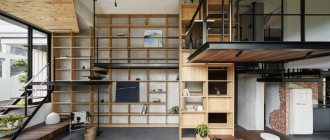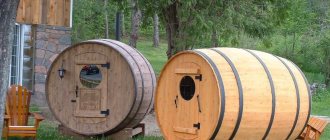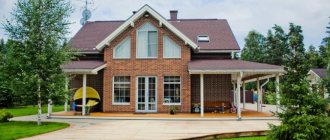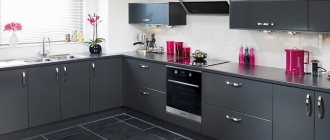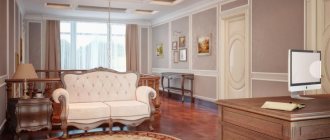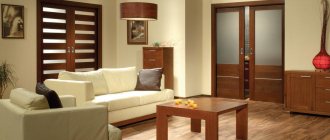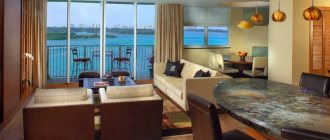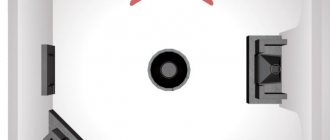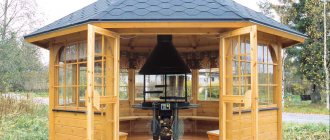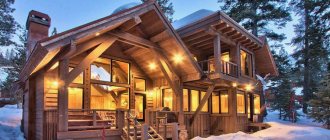Selection of material and stages of work
There is no better building material for a bathhouse than coniferous wood. However, there is a pitfall - some varieties have increased resin content and therefore can be used for the construction of the box, but for finishing it is better to find an alternative. Pine and cedar have excellent properties.
Their healing effect from essential oils is described in medicine, however, breathing vapor at high temperatures is prohibited. The airways and pores have a detrimental effect, the resins clog them, doing the same with their wounds on the trunk. It is better not to use these varieties for steam rooms, but to use a spruce board - this species has the least leakage.
What to choose as a building material – timber or logs? It's a matter of wallet. If the bathhouse will not be used in the winter - for example, a summer cottage with a seasonal stay, then timber will be enough.
For a residential building, a bathhouse in winter is a blessing. Then a log is a must - the object will require less time to warm up. You can repeat the material of the house and build a bathhouse according to it, then the two objects will be built as a single complex.
The construction of a bathhouse follows similar stages as a residential building:
- Base.
- Construction of the frame of the house and its veranda.
- Roof.
- Interior work and finishing.
Each stage has its own nuances, which should be considered in advance, before starting work. Details below.
Bathhouse project with veranda
A do-it-yourself veranda attached to a bathhouse is usually used as a place to rest after taking procedures. It's very convenient and pleasant. However, an object constructed outside the common foundation may create problems in the future - uneven shrinkage, deformation of the roof, etc. It is better to leave such structures to professionals - they will draw up a verified project, focusing on the finished object, and will carry out the work of connecting to the bathhouse correctly and efficiently.
Owners building a bathhouse from scratch should initially consider projects with verandas - this way you can avoid the problems described in the future, and it will be much easier to obtain a building permit than creating your own options that lack engineering thought.
Expert recommendations take into account the following:
- For three people to be in the steam room at the same time, the comfortable area should be up to 10 m². The height of the room is 2 m. Such parameters will allow rational use of heat sources.
- Natural drainage of water is required - the construction of the subfloor is made at an angle.
- The entrance and windows are located on the south side - this will again reduce heat loss. In addition, in winter, less snow accumulates on this side, and it begins to melt earlier.
- All communications related to energy must be of increased safety due to interaction with steam. These are special cables and lamp shades - you cannot save on this.
It is difficult for amateurs to take into account all the nuances, so when performing this or that work, you should understand in advance all the processes associated with it, and not deviate from the sequence of actions.
Features of baths with a terrace
Undoubtedly, a bathhouse with a terrace provides significant freedom in the use of space. At the same time, the size of the terrace can be absolutely any and depends on your preferences. The main purpose of a terrace is to be a relaxation area, providing a relaxing outdoor atmosphere.
Modern terraces for baths differ in design features, so they are divided into several types:
- Frontal - located along the facade
- Side – adjacent to one of the end sides
- Corner - arranged along two adjacent walls
- Encircling - go around the entire building around the perimeter
For some, it may seem that adding a terrace to the bathhouse would not be advisable, since this leads to an increase in the cost of the entire structure. But I would like to draw your attention to the fact that a terrace for a bathhouse allows you to avoid cluttering the site with a large number of buildings, and allows you to save money. Since the construction of a separate gazebo or barbecue house will end up being more expensive.
Advantages of a bathhouse with a terrace
- Aesthetics and additional beauty of the entire structure
- Expanding the functional area of the bathhouse at low cost
- A great way to take air baths outdoors with all the amenities
- An excellent opportunity to build additional devices, for example, a barbecue oven or grill
Each person has his own individual needs, ideas about architecture, and financial capabilities. Therefore, when choosing a bathhouse project, try to understand what you really like. After all, first of all, you build for yourself! Whichever bathhouse will be located on your site, it will bring you the maximum pleasure.
You can order the construction of a bathhouse with or without a terrace according to an individual or ready-made project, as well as ask questions to our specialists in Moscow and the Moscow region by calling +7 (980) 624-24-24, email or through the online form on our website.
Base
If there are no prerequisites for installing a monolithic slab - floating soils or high groundwater levels - then you can opt for a columnar platform. This will be useful in a sense - moisture will flow freely to the ground and the floorboards will remain dry. How to do:
- The area is cleared of flora and fauna and leveled. Be sure to use a level - the foundation should descend evenly.
- Holes are dug under concrete pillars or pouring and cushioned with crushed stone and sand. The installation frequency is regulated by the project. The veranda also requires supports.
- The foundation must withstand its term - for log baths, the area of which is impressive, this period is at least six months.
When the foundation is completely ready for further work, it is checked for compliance with the level - the ends of the pillars or racks must be in the same plane. If this is not the case, then the base is brought into the desired state using a circular saw. The finished foundation is tarred with bitumen mastic.
Box
Construction from logs has its own nuances:
- The first mortgage crown is placed on a larch board - it will not interact with dampness.
- Immediately install the floor joists and install the subfloor.
- When building from a simple planed log, the elements alternate - butt to top. This way, the level of the walls will be maintained.
- The elements are secured with wooden dowels - square rods, similar to the handles of shovels.
- Corner joints for a bathhouse are made into a bowl - this way, heat loss is reduced and the object will freeze less in winter.
- Each crown is interspersed with a jute seal - the material is non-hygroscopic and is not of interest to birds and rodents.
- All window and door openings are cut out after the peak of shrinkage, that is, after a year.
The rafter system is not installed immediately - the log is a capricious material, and it is not possible to know how the box will behave during the shrinkage period. Therefore, to avoid collapse, the roof is made last.
LiveInternetLiveInternet
Quote from Vilar's message
Read in full In your quotation book or community!
Entrance to the bathhouse.
Dressing room and terrace This article will tell you how to properly organize the entrance to the bathhouse. For a Russian person, a bathhouse is not just a room where you can wash and steam. The bathhouse is a whole cult. There are many different traditions and rituals associated with the bathhouse; just remember our favorite movie “The Irony of Fate, or Enjoy Your Bath!” Therefore, it is quite understandable that everyone wants to have this useful structure on their site. But building your own bathhouse according to all the rules so that it faithfully serves the benefit of your soul and body for many years is quite difficult. There are many nuances that should be taken into account when building a bathhouse. Just as a theater begins with a hanger, so a bathhouse begins with the entrance, or, to be more precise, with the dressing room . The entrance to the bathhouse itself is usually made on the south side for easier entry in winter. Of course, this is not important, and if you regularly clear the snow around your bathhouse, then the entrance can also be located from the north, east, and west. The main function of the dressing room is to prevent cold air from the street from entering the steam room, but in addition, the dressing room is a multifunctional room in which you can undress, as well as relax and cool down after the steam room. As a rule, a window opening is made in the dressing room, but doors and windows should be small in size to preserve and retain heat inside the room. Therefore, sauna doors are usually 160-180 centimeters in height and 60-80 centimeters in width. Moreover, the door leading from the dressing room to the steam room must be installed in such a way that it opens inside the dressing room, in order to avoid wet clothes. The area of the dressing room may vary, depending on the capabilities and desires of the owner, but usually the dressing room is a small room of about 4-6 square meters. Insulation of the dressing room is mandatory. For convenience and functionality, there should be nothing superfluous in the dressing room. The standard set is a wide bench for relaxation, a table and a hanger. But everyone can supplement this set with other necessary items. In the corner of the dressing room you can put a shelf for storing all kinds of oils, shampoos and other hygiene products. The bookcase can be successfully replaced with a hanging cabinet to save space. Fans of long gatherings after the steam room can place a TV and refrigerator in the waiting room, but in this case, special attention should be paid to the serviceability and safety of the electrical wiring. If you use a bathhouse only in the warm season, it is quite possible to build a terrace instead of a dressing room . One does not exclude the other, so a terrace can exist along with a good insulated dressing room. As a result, you will kill two birds with one stone: you will have a terrace for relaxing after the steam room in the summer, and a dressing room for a comfortable visit to the bathhouse in the winter. When building a terrace, no one limits your imagination, so you can design it however you like. But, of course, you should put country furniture on the terrace for comfortable relaxation and organize lighting. Ultraviolet lovers use special emitting lamps for these purposes. Thus, we can come to the conclusion that the construction of the bathhouse itself and the entrance to the bathhouse is a creative activity. But do not forget about the necessary nuances and rules developed over the years, then the steam in your bath will always be light.
Author: Maria Ilyina
https://diy.ru
Construction of a veranda
The supporting crowns for the veranda are placed without separation from the main building - the connections must be located under the walls of the bathhouse. Since the veranda is a lightweight object, for its construction you can use timber with a cross-section of 150 mm or more. Further:
- Install racks. They should immediately receive harnesses - upper, lower and middle.
- For ease of work, subfloors are immediately filled.
- The walls are raised - if the veranda is completely glazed, then they are raised to the required level.
- A do-it-yourself wooden bathhouse with a veranda will be under the same roof, which means that the construction of the rafter system will be postponed until the shrinkage period.
You can attach a metal veranda frame to the bathhouse. It is mounted by welding and has many advantages over wood - strength, durability. The only drawback is the susceptibility to corrosion, and bathing procedures increase this risk.
Veranda to the bathhouse with your own hands from the foundation to the glazing
The construction of a small bathhouse always entails an expansion of the area. Gradually, the owners realize that there is not enough rest room, and there is not enough space for guests. How to solve the problem without spending a lot of money and effort? There is an exit! The veranda to the bathhouse will add romance, airiness to the building and add usable space. The veranda can be made open or closed, and can be used not only in the warm season. Let's look at how to attach a veranda to a bathhouse with your own hands in more detail in this article.
The veranda to the bathhouse can be used as a place for receiving guests and relaxing
Practical placement of the veranda to the bathhouse
How to place the structure and where to build it is not an easy question. The most practical and inexpensive option is to make an extension directly in front of the porch, so there will be no need to change the layout and the veranda will fit organically into the building.
The easiest way is to place a veranda extension on the side of the bathhouse.
But there are modern ways to place a veranda next to your bathhouse. Let's take a closer look at some of them, reviews of which are mostly positive.
Shape and its features
A veranda is not always a rectangular extension with regular shapes. Semicircular, oval or triangular attached models look organic. Especially if the facade is completely glazed and has an original design. These will not only become a decoration and highlight of the bathhouse, but will also be a gathering place for your guests.
The semicircular veranda looks rich.
It will be more difficult to build a semicircular or oval structure with your own lessons, but the bathhouse will look modern and original.
Design features
The veranda can be either part of the bathhouse or a separate building. When the structure is built separately, it is connected to the bathhouse by a covered corridor. A long or corner model can be divided into two zones: a kitchen and a relaxation room. Traditionally, for a long model, the largest bath wall is chosen, but this is not a prerequisite. The structure may have several exits: the main one and the one to the garden or pool.
Covered veranda to the bathhouse under a separate roof.
The veranda can be fully covered or partially open, with a balcony or loggia. The loggia is used only in the warm season; it usually overlooks the garden. You can divide the interior into a small dressing room and a main part with a seating area. In large models, craftsmen manage to place a guest room, which is used in the summer.
All the nuances are worth noting when drawing up a diagram. You should not start construction without first diagramming the chosen option. The plan will help not only not to make mistakes during construction, but also to correctly calculate the building material.
What material is suitable for constructing a veranda?
Traditionally, the same material from which the bathhouse is assembled is used to build a veranda. But you can approach the issue with imagination and make a model from a completely different material. So, for a brick bathhouse you can build a terrace from timber or rounded logs. With proper finishing, the design will look harmonious.
You should not build an extension to an already established wooden bathhouse from material with natural moisture. The shrinkage of the structure will be uneven and the terrace will be skewed. Take the choice of material seriously; its quality will determine not only how long the building will last, but also its appearance.
Once the design and material have been selected, you can proceed to construction. It will not be difficult to cope with the construction of a terrace with your own hands, the main thing is to follow all the details and instructions.
Choosing a foundation for the veranda
It is easier to build a terrace together with a bathhouse, so the shrinkage of the structure will be uniform and you will not have to fasten two foundations together. But alas, not everyone thinks about the veranda at the stage of building a bathhouse.
Schematic design of the veranda to the bathhouse.
The weight of the terrace is small, so a simpler foundation option is chosen for it. Since it is in any case better to install the veranda on a separate foundation, you can use a trick and illusoryly create the effect of structural integrity. To do this, place the veranda as close to the bathhouse as possible, leaving a gap of 20–30 mm between them, which is then filled with polyurethane foam or mineral wool and covered under the casing.
To ensure that two different bases do not harm each other, everything must be carefully calculated and the characteristics of the soil taken into account. It often happens that the soil on an area of 1–3 m is different.
Between themselves, the bathhouse and the terrace, if calculated correctly, will behave like exemplary neighbors and cracking and separation will not occur. But for strength, you can connect the foundations with metal brackets, 1-2 at the joining points. They will not reduce the load, but will not allow the veranda to move away from the bathhouse.
For a small lightweight veranda, strip or columnar types of foundation are suitable. The columns are laid out under load-bearing walls in 1 m increments.
Assembling veranda walls
The easiest way is to build a frame terrace with your own hands. The walls are assembled from the bottom trim. The lower log or beam is taken with a larger section, so if the main one is 100x100 mm, then the strapping should be made of 100x150 mm. All wooden elements are treated with antiseptic compounds before assembly.
The veranda posts are attached to each other using metal corners.
The frame is attached to the foundation using metal anchors. Anchors attract the tree to the base using a nut and washer. It is necessary to lay anchors at the stage of pouring the foundation.
The bottom trim must be secured with a level. It must be strictly horizontal. After the bottom trim, vertical posts are attached. There are two ways to attach the racks:
- cutting;
- using metal corners.
The second option is easier to do yourself. But it is better to take reinforced, galvanized corners. Each rack is secured on both sides with corners, and to provide rigidity, temporary jibs are attached. Jib beams can be used small for each rack separately or long for several beams at once.
The vertical beams should be fastened so that the windows and doors of the veranda are between them, otherwise it will be impossible to leave the opening in the right place.
Next, attach the upper harness to the lower trailer. In the corners, the strappings are joined using corners or notches.
The walls are insulated with mineral wool or ecowool and sheathed simply with boards or panels. The top of the veranda is sheathed with imitation timber, block house or siding.
The floors on the veranda may or may not have additional insulation, but the ceiling will have to be additionally insulated.
Glazing of the veranda - subtleties and features
The veranda attached to the bathhouse is rarely built warm, but in any case it has glazing. Windows give the veranda airiness and light. You can glaze the veranda in several ways:
- Full glazing;
- Partial glazing.
Let's look at the features of each type in more detail.
Full glazing
With a fully glazed veranda, the walls consist of almost nothing but large windows. All windows are panoramic, in some cases considered small.
Balcony windows on a fully glazed veranda are installed along the entire perimeter.
The windows are not made to open, but for better ventilation they are made with 1–2 vents. Making full glazing yourself is difficult.
Partial glazing
Partial glazing is a structure in which 120 cm of walls are assembled from lumber or brick, and the rest is glazed. You can glaze using the type of balcony frames, an easy way to do it yourself.
The veranda can be partially glazed or completely open.
Due to the large number of windows, the veranda is always bright until sunset, and it is not necessary to add additional lighting. For large verandas with a guest room, some of the windows are covered with curtains or blinds are installed.
How to make a veranda roof correctly
The roof structure of the veranda can be separate or common with the bathhouse. It all depends on the design features of the veranda.
When the gable of the bathhouse is located above the veranda, the roof is combined and made into a common slope. The good thing about the option under a common roof is that there is no need to think through the water drainage system.
For a structure located perpendicular to the gable, it is easier to make a separate roof. A single-slope roof is made with your own hands, and the upper part should extend 15 cm under the slope of the bathhouse roof, so water will not get inside the veranda. The slope has an angle of inclination depending on the selected roofing material and wind load.
The roof is assembled using the following technology:
- The rafter system is being installed.
- Vapor and waterproofing is attached to the top.
- Next, the lathing is done in increments depending on the chosen roof.
- Roofing material is being laid.
The roofing material chosen is the same one that lies on the roof of the bathhouse. So, the design will fit into the overall design.
What verandas to the bathhouse are like can be seen in more detail in the video:
The veranda will give the bathhouse a special coziness and the owners will not have to think about where to place guests at a large table during the rain or in the heat, when insects do not allow them to sit in the open air.
banyabest.ru>
Roof
You cannot deviate from the project - even simple gable roofs require great responsibility. For a rafter system of this type you will need:
- Timber with a cross section of up to 150 mm.
- Beam 50 mm.
- Fasteners – anchor bolts, brackets. Self-tapping screws are too unreliable.
Sequence of work:
- The central part – the ridge – is installed. This is a prefabricated structure in the form of a wooden frame.
- The rafter legs are attached to the penultimate crown - it is not secured with anything during the construction process.
- The gables in the form of shields can be assembled on the ground and then moved upstairs in finished form.
- The rafters are covered with sheathing, into the sectors of which insulation is inserted, and this, in turn, is covered with waterproofing.
- The last step will be laying the roof. Its choice depends on the angle of inclination - the steeper, the more structural the material. For gentle slopes, you need a smooth coating - corrugated sheet, ondulin.
The construction of the bathhouse with a veranda is almost complete. All that remains is to carry out the interior work and finishing.
Do-it-yourself frame bathhouse - projects with a 5x4 and 3x4 attic
The bathhouse is not a permanent building, but its functional features do not allow construction to begin without a design. Frame technology is ideal for this type of structure: it is quickly erected, environmentally friendly materials are used, does not require large material and human resources, and is easy to design.
We design ourselves: modern types of baths
Ready-made design documentation for a bathhouse made of timber with an attic or any other can be purchased at special bureaus or completed independently. In the second case, any standard project for the selected size of the building will come to the rescue.
Before starting to design a bathhouse based on a frame, key issues are resolved:
- find the most rational location of the building, taking into account convenience and simplicity for the provision of water, sewerage and lighting communications;
- plan the size of the future building;
- at the selected location, study the composition of the soil and differences in the ground surface. These factors will be decisive in choosing the type of foundation;
- solve the need to build 2 floors, an attic and the construction of external elements such as a veranda, terrace;
- determine the type of roof. Options for single-slope, double-slope and multi-slope structures are being considered.
When choosing the number of roof slopes, the size of the bathhouse, the climatic features of the area, the distance to other buildings, and the type of coating are taken into account.
The finished project will become an assistant in the rational distribution of spaces and the choice of building materials. Photos of bathhouses will also help you decide on your preferences.
Preliminarily think through the internal layout of the bathhouse in terms of functionality. Determine the installation location of the stove. It determines how the chimneys and ventilation will be located.
At the design stage, the issue of choosing the materials from which the structure will be built is decided and the approximate cost of construction is calculated. The more detailed the design of a frame bathhouse is developed with your own hands, the easier it is to make adjustments to it if unforeseen circumstances arise.
Option 4*5 m
The building, measuring 20 m2, is compact and suitable for a bathhouse consisting of three rooms:
When determining the dimensions of interior spaces, the calculation is made not for the “pure” size, but taking into account the thickness of the partitions and walls.
The most suitable area for a relaxation room is 7-8.5 m2, for a steam room - up to 5 m2, for a bathroom - at least 2.2 m2. The small size of the building does not require a dressing room. The steam room houses the heater and the entire main surface of the stove. A firebox is brought into the rest room, which also plays the role of a heating device. To prevent cold air from entering the bathhouse from the street, it is necessary to provide a closed porch.
Consumables and elements of a 4*5 m bath:
- The foundation is a strip foundation buried 70 cm and a plinth height of 40 cm. Its arrangement requires a gravel cushion up to 20 cm thick.
- The frame consists of posts and trim along the upper and lower edges of the structure. It is optimal to use boards 100*50 mm.
- The roof is gable with a rafter system made of 150*50 mm boards. Laying pitch 580 mm.
The cladding is selected depending on the required level of thermal insulation.
Option 6*6 m with veranda, balcony
The size of 6*6 m gives space for imagination. The design of such a bathhouse can include the following premises:
- terrace or vestibule;
- rest room and bedroom;
- steam room;
- full bathroom;
- washing room
Linear dimensions require the use of standard length lumber, which reduces the cost of construction due to the small amount of waste.
The washing room can be made extremely large with direct access from the steam room and place sun loungers in it. In another version of the project, it is planned to separate the washing room and the steam room with a small corridor connected to the rest room. In this case, the washing room will be somewhat smaller.
Option 6*3 m: design with terrace
The design of a 6*3 m bathhouse with a terrace comes in two versions:
- The terrace is not included in the area of the building and its size is planned separately. In this case, the overall size of the building will increase by the area of the veranda.
- The terrace is part of the common building. Then all interior spaces will be smaller.
The small size of the bathhouse will not allow you to equip a full-fledged bathroom. The stove will be heated from the rest room.
Choose a compact stove, perhaps the model will be narrow and elongated upward.
Moving the terrace beyond the foundation of the main building will allow you to allocate a small space from the rest room for a vestibule . Then it is possible to take a steam bath in winter. Approximate dimensions of interior spaces:
- steam room – 3.5 m2;
- shower/washing room – 1.8 m2;
- relaxation room – 8.5 m2;
- vestibule – 2.6 m2;
- outdoor terrace – 11 m2.
To form the frame you will need a beam of 100*150 mm. They are strapped and floor joists are installed. For the roof, use 150*40 mm timber for the ceiling. The rafter system is laid from edged boards. A board with a size of 100*50 mm is suitable for this. The material for cladding and roofing is selected depending on personal preferences and climatic conditions.
Option 4*4 m with terrace
This size of the building assumes only an external, attached terrace, but under a common roof and on a common foundation.
An area of 4*4 m is larger for dry saunas. For Russian baths, this is not the most comfortable option.
The project involves dividing the common space into two parts of 8 m2 each and adding a terrace up to 6 m2 in size:
- A relaxation room after the steam room, also known as a dressing room.
- Steam room and sink.
The steam room should be made larger than a washing room. Then it will be possible to accommodate two people.
Option 5.4*6.3 m
A bathhouse with a total area of 34 m2 may have a built-in terrace. In this case, up to 2/3 of the total area is allocated to the interior. A typical project suggests the following room sizes:
- for relaxation in 11-12 m2;
- for the steam room – 5 m2;
- for sanitary needs - up to 6 m2.
The rest of the space will be occupied by the terrace. It is convenient to make part of the terrace closed so that warm air does not immediately escape into the street.
If a veranda is not planned, then a dressing room with an area of 5.4 m2 is made and the presence of a bathroom can be planned.
The main advantages of frame technology
Advantages of frame buildings:
- the design is simple and it is possible to design and build it yourself;
- the building does not shrink and finishing work and installation of equipment begin immediately after the main construction;
- construction proceeds quickly, without restrictions on the time of year;
- the lightness of the design makes it possible to install any type of foundation;
- Any materials for cladding are suitable. Everything depends on material capabilities;
- environmental friendliness of the building;
- economic benefit in comparison with stone and brick buildings.
To perform the work, it is not necessary to involve heavy equipment and a whole team of workers. Simple construction tools and a maximum of one assistant will do.
What disadvantages do we take into account during construction?
Like all wooden buildings, a frame bathhouse will have an increased fire hazard. The design should take into account additional treatment with special compounds that will reduce flammability. Insulation materials are selected from the point of view of combustion resistance.
When building frame baths, you cannot skimp on the quality of electrical work. Electrical wiring is placed in non-flammable casings. When installing any electrical appliances, grounding is required.
High humidity in the bathhouse can lead to the destruction of mineral insulation if it is not covered with a vapor barrier. Therefore, it is recommended to use more functional materials as insulation.
All of the above disadvantages lead to higher construction costs.
Necessary materials.
A building built on a frame consists of the following elements:
- timber frame;
- cladding from finishing materials on the inside and outside;
- laying insulation, vapor barriers between parts of the sheathing;
- foundation of any type. The most commonly used are shallow belt or pile ones. Depending on the project, other types may be used.
Each element can reduce the cost or, on the contrary, make the final product more expensive, due to the selected materials.
To assemble the frame and floor joist rafter system, timber from high-quality tree species with parameters of 100*150 mm is used. The stability of the structure can be increased by using 150*150 mm bars. Modern technologies offer laminated veneer lumber. For the remaining elements, smaller beams are selected. Any lumber or plywood is suitable for sheathing.
The following can be used as roofing material:
- roofing felt;
- corrugated sheeting;
- folded covering;
- metal tiles;
- Euro slate.
Ceramic tiles are very heavy and will create additional stress on the foundation.
Apart from the joists, the floor has a rough covering. It can be plywood, any type of board, special boards. Materials that imitate natural logs have worked well as external cladding. Various types of lining can be used inside.
All wooden elements must be treated with fire retardants and antibacterial mixtures.
Insulation materials are selected that are resistant to rotting and burning. These are mainly mineral wools. The insulation layer is determined by the climate of the region where construction is taking place. If other types are chosen, you must read the instructions so that they are resistant to high temperatures and do not support combustion.
Additionally, mounting materials and interior finishing are purchased. Principle of choice: lightweight, moisture-resistant, fireproof.
DIY frame bathhouse, video
Building a frame bathhouse is not difficult. If you approach the planning stage responsibly, construction will proceed quickly and at minimal cost. And after a few weeks, you can come in and have fun.
Bathhouse projects with a gazebo under one roof: a combined extension with barbecue and barbecue
Angle of inclination of the blind area: options for arrangement around the house, how to make formwork - design
How to make a barbecue from a gas cylinder: making it yourself from propane - drawings with dimensions
Maran chickens: French and black-copper rooster - description of the breed
